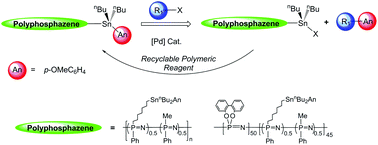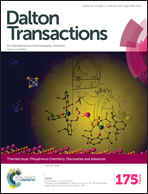Polyphosphazenes for the Stille reaction: a new type of recyclable stannyl reagent†
Abstract
A random phosphazene copolymer {[N![[double bond, length as m-dash]](https://www.rsc.org/images/entities/char_e001.gif) P((CH2)7–Br)Ph]0.5[N
P((CH2)7–Br)Ph]0.5[N![[double bond, length as m-dash]](https://www.rsc.org/images/entities/char_e001.gif) PMePh]0.5}n (2) and a block copolyphosphazene {[N
PMePh]0.5}n (2) and a block copolyphosphazene {[N![[double bond, length as m-dash]](https://www.rsc.org/images/entities/char_e001.gif) P((CH2)7–Br)Ph]0.5[N
P((CH2)7–Br)Ph]0.5[N![[double bond, length as m-dash]](https://www.rsc.org/images/entities/char_e001.gif) PMePh]0.5}45-b-[N
PMePh]0.5}45-b-[N![[double bond, length as m-dash]](https://www.rsc.org/images/entities/char_e001.gif) P(O2C12H8)]55 (5), having a branch with two randomly distributed units, have been synthesized and used as precursors for the stannyl derivatives {[N
P(O2C12H8)]55 (5), having a branch with two randomly distributed units, have been synthesized and used as precursors for the stannyl derivatives {[N![[double bond, length as m-dash]](https://www.rsc.org/images/entities/char_e001.gif) P((CH2)7–SnBu2An)Ph]0.5[N
P((CH2)7–SnBu2An)Ph]0.5[N![[double bond, length as m-dash]](https://www.rsc.org/images/entities/char_e001.gif) PMePh]0.5}n (3) and {[N
PMePh]0.5}n (3) and {[N![[double bond, length as m-dash]](https://www.rsc.org/images/entities/char_e001.gif) P((CH2)7–SnBu2An)Ph]0.5[N
P((CH2)7–SnBu2An)Ph]0.5[N![[double bond, length as m-dash]](https://www.rsc.org/images/entities/char_e001.gif) PMePh]0.5}45-b-[N
PMePh]0.5}45-b-[N![[double bond, length as m-dash]](https://www.rsc.org/images/entities/char_e001.gif) P(O2C12H8)]55 (6, An = p-MeOC6H4). Polymers 3 and 6 were tested as recyclable tin reagents in the Stille cross-coupling reaction with ArI, using various Pd catalysts and different experimental conditions. Polymer 6 can be recycled without a significant release of tin, but its efficiency decreased after three consecutive cycles. This effect was explained by studying the self-assembly of the polymer under the same conditions used for the catalytic experiments, which evidenced the progressive coalescence of the polymeric vesicles (polymersomes) leading to stable and bigger core–shell aggregates by the attraction of the [N
P(O2C12H8)]55 (6, An = p-MeOC6H4). Polymers 3 and 6 were tested as recyclable tin reagents in the Stille cross-coupling reaction with ArI, using various Pd catalysts and different experimental conditions. Polymer 6 can be recycled without a significant release of tin, but its efficiency decreased after three consecutive cycles. This effect was explained by studying the self-assembly of the polymer under the same conditions used for the catalytic experiments, which evidenced the progressive coalescence of the polymeric vesicles (polymersomes) leading to stable and bigger core–shell aggregates by the attraction of the [N![[double bond, length as m-dash]](https://www.rsc.org/images/entities/char_e001.gif) P(O2C12H8)] rich membranes, thus decreasing the accessibility of the tin active centers.
P(O2C12H8)] rich membranes, thus decreasing the accessibility of the tin active centers.

- This article is part of the themed collection: Phosphorus Chemistry: Discoveries and Advances

 Please wait while we load your content...
Please wait while we load your content...